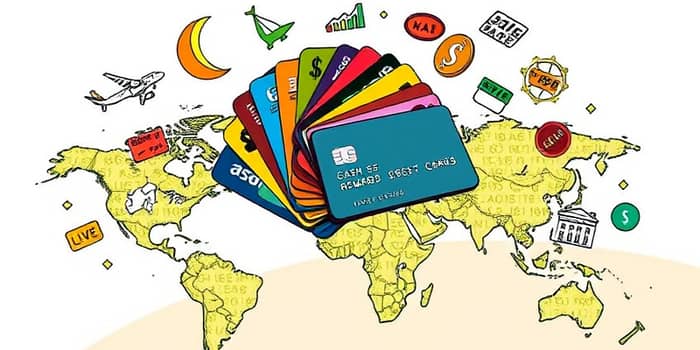Credit cards are one of the most powerful financial tools available today, offering a range of features and benefits that can suit nearly every lifestyle and spending pattern. This guide explores the various categories of credit cards, breaks down their key features, and helps you choose the card that aligns with your goals.
What is a Credit Card?
A credit card is a payment card issued by a financial institution that allows cardholders to borrow funds up to a predetermined limit in order to pay for goods and services. When you use a credit card, you are essentially taking out a short-term loan that must be repaid by the statement due date or over time with interest if you carry a balance.
Understanding how credit cards work is fundamental to managing your personal finances effectively. Responsible use can build your credit score, unlock valuable rewards, and provide purchase protections. Misuse, however, can lead to high interest charges and damage your financial health.
Overview and History of Credit Cards
The concept of plastic money dates back to the early 20th century, but it was in the 1950s that modern credit cards emerged. Diners Club introduced the first multipurpose charge card in 1950, and Bank of America launched the first general-purpose credit card in 1958.
Since then, credit cards have evolved dramatically. Innovations such as magnetic stripes, EMV chips, contactless payments, and mobile wallet integration have transformed how consumers access credit. Today, credit cards are a $106.67 billion global market with a projected value of $114.55 billion by 2029.
Key Categories of Credit Cards
Credit cards can be broadly classified into several main types. Each category caters to different financial goals and spending habits.
- Rewards Credit Cards
- Low-Interest and Balance Transfer Cards
- Credit-Building and Student Cards
- Business and Store Cards
- Charge Cards and Prepaid Cards
Rewards Credit Cards
Rewards cards offer points, miles, or cash back for every dollar spent. These cards are ideal for individuals who pay off their balances in full each month and want to maximize benefits from routine purchases.
There are three primary subtypes:
- Flat-rate cash back on all purchases—Cards that reward every purchase at a fixed rate (e.g., 1.5% cash back).
- Category-based bonus rewards—Cards that offer higher percentages in rotating or fixed categories like groceries, gas, or dining.
- Travel loyalty points and frequent flyer miles—Cards that accumulate airline miles or hotel points for redemption on flights, stays, and upgrades.
Many reward cards also include perks such as airport lounge access, travel insurance, and credits toward TSA PreCheck or Global Entry fees.
Low-Interest and Balance Transfer Credit Cards
These cards feature 0% introductory APR on balance transfers for 12–21 months and lower ongoing interest rates thereafter. They are designed for consumers who carry balances and want to reduce interest expenses or consolidate high-rate debt into one manageable payment.
Key features include:
- Long introductory periods with no interest.
- Lower standard APR compared to typical credit cards.
- Minimal or no annual fees in many cases.
Credit-Building and Student Credit Cards
Secured credit cards require a refundable cash deposit equal to your credit limit, making them ideal for people with poor or no credit. Responsible use leads to credit line increases and eventual eligibility for unsecured cards.
Unsecured student cards often feature lenient approval standards and rewards like cash back on common college expenses. They provide a safe way to establish a credit history for young adults.
Small Business and Store Credit Cards
Business cards offer expense tracking tools, employee card options, and bonus rewards for categories like office supplies, advertising, and travel. They help entrepreneurs separate personal and business spending while earning rewards.
Store cards are co-branded with a specific retailer and typically offer discounts or promotional financing on purchases. While they can be easier to qualify for, they often carry high APRs and restrictions on where they can be used.
Charge Cards and Prepaid Cards
Charge cards require full payment each month and do not have a preset spending limit. They can provide unlimited purchasing flexibility for qualified buyers but impose hefty fees for late payments.
Prepaid cards are loaded with funds in advance and function like debit cards—no interest or borrowing is involved. They are not true credit products but can help with budgeting and online purchases.
What to Consider When Choosing a Card
To select the best credit card for your needs, evaluate the following criteria:
- Annual fees versus potential rewards—Do the benefits exceed the cost of holding the card?
- APR and interest charges—Are you likely to carry a balance?
- Credit score requirements—Does your credit profile meet the issuer’s thresholds?
- Perks and introductory bonuses—Can you meet the spending minimum for signup offers?
- Foreign transaction fees—Essential for frequent travelers.
The Application and Approval Process
Applying for a credit card typically involves an online form requesting personal information, income, and employment details. The issuer then evaluates your credit report, income stability, and debt-to-income ratio.
Approval times vary from instant decisions to a few weeks for manual reviews. If denied, you’ll receive a notice with the main reasons and information on how to improve your chances in the future.
Market Trends and Outlook
The global credit card market continues to expand, fueled by e-commerce growth, contactless payments, and the integration of AI-driven fraud protection. Consumers are increasingly seeking sustainable and digital payment solutions that align with their lifestyles.
Common Pitfalls and How to Avoid Them
Even the best credit cards can become liabilities if misused. Watch out for:
- Overspending beyond your ability to pay off balances.
- Missing payments and accruing high late fees.
- Excessive balance transfers without payoff strategies.
- Ignoring annual fees and fee offsets.
Conclusion
Credit cards come in many forms, each designed to meet specific financial needs—from building and repairing credit responsibly to earning premium travel rewards and managing business expenses. By understanding the differences between card types and evaluating your spending habits, you can choose a card that maximizes your benefits and supports your long-term financial goals.
As the credit card market grows and evolves, new features and innovations will continue to emerge. Stay informed, compare offers, and use your credit card as a strategic tool to improve your financial well-being.
References
- https://www.cardratings.com/credit-card-list.html
- https://www.bankrate.com/credit-cards/advice/different-types-of-credit-cards/
- https://www.nerdwallet.com/article/credit-cards/types-of-credit-cards
- https://www.td.com/us/en/personal-banking/learning/types-of-credit-cards
- https://www.capitalone.com/learn-grow/money-management/types-of-credit-cards/
- https://www.researchandmarkets.com/report/credit-cards
- https://www.investopedia.com/terms/c/creditcard.asp
- https://www.huntington.com/learn/credit-debt/types-of-credit-cards










